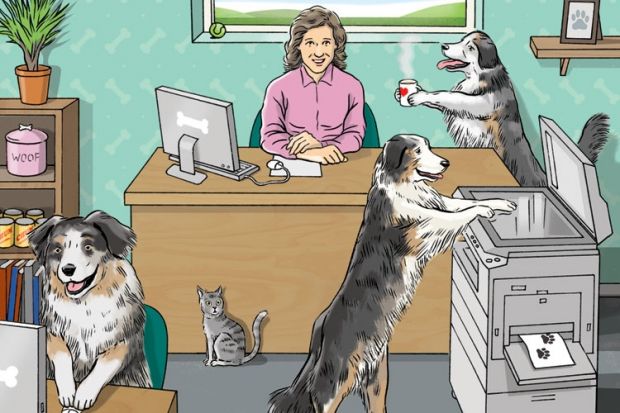Source: Daniel Mitchell
You will usually find me in my office. Me and several Australian shepherds – dogs, that is. I’m lucky to work at a university with a pet policy that allows this. There is evidence that the presence of other animals helps to keep humans healthy and happy. Just looking at animals has been found to stimulate the release of oxytocin in humans, making us happier and calmer. And so it makes sense that recent studies have shown that the presence of pets in the workplace reduces conflict and increases cooperation.
I can attest to all these findings. I am also more productive when Maeve, Tao and Kira are flopped around my desk. More work gets done when people are not worried about leaving dogs (and sometimes cats) at home or having to run home at lunchtime to let a dog out. I am more likely to spend more time in my office when the dogs are there.
In the academic setting, the presence of other animals also has some unique and unexpected benefits for students. This is why some colleges and universities have pet-friendly halls of residence and have found that the students living there have more success and persist to graduation. Some staff also bring pets on campus during finals week so that students can de-stress by petting a cat or a dog.
But the dogs in my office perform a more specialised pedagogical function.
Many students live on campus, away from home and miss the animals in their lives. They come by the office with a simple question, but spend time petting the dogs. During that time other conversations occur and more questions emerge. Asking the students about their own associations with other animals often opens up conversations about life in general. Making this kind of connection is one important way to create the space in which meaningful learning can occur. Students begin to see me as a person rather than a professor, and I get to see them in a new light as well – namely, as caring adults.
The dynamic in the classroom often changes too. Not only do students feel more comfortable coming back to my office after class (often initially just asking if they can come to see the dogs), many begin to feel more comfortable speaking in class because they’ve spent time talking to me in a less formal setting.
Of course, one needs to make accommodations for students and co-workers with allergies, and those who feel uncomfortable around animals. I let everyone in my classes know about the dogs and arrange other places to meet if they so desire. There is a sign on my door letting people know there are dogs in my office. I worry, however, that unless more people come to understand the important work done by pets in the workplace and on campuses, these kinds of arrangements will remain the exception rather than the rule – at least in the US.
We live in an increasingly risk-averse society and so we are inclined to see everything as a potential problem. We usually think about dogs in the workplace in terms of bites, allergies and waste. Along these lines, we increasingly confuse the idea of individual rights with the right of individuals to have the world arranged just for them and their comfort. One of my jobs as a professor is to disabuse my students of this notion, to help them see that working and living in communities requires compromise and mutual accommodation. If the purpose of a college or university campus is to create a space for students to productively engage with teaching and learning, there is plenty of evidence to suggest that the presence of pets will help.
It is much more common to find dogs in public places in other countries. In Germany and France, dogs ride the bus and frequent restaurants. As a result, the dogs and their owners learn how to navigate shared spaces. This goes beyond picking up pet waste – which continues to be a challenge for some owners – to include good manners (for dogs, not jumping on people or picking fights).
Not all pets will be comfortable in all workplaces. We need to be fair to them, to consider their needs and interests. If someone rescues an abused dog, for example, it may never be confident enough to be safe and happy in a setting where he or she meets many different people in a day. Similarly, it might not be a great idea to expect a young husky to spend eight hours sitting around. An older dog might be a good choice. Some, however, have special needs that might require some other adjustments, such as more frequent walks so they can relieve themselves. But the benefit of having non-human colleagues is worth the trouble.
At this point in my oldest dog’s life, he has become uncomfortable being in the office if I’m not there. After years of happily hanging out it seems that his increasingly poor eyesight makes him anxious when alone and he starts to whine. After trying a few things, to be fair to others in my building he no longer comes in unless I can be there with him. But the other two girls continue to interact with students. To them – and me – a day without students coming to my office is disappointing.
I have done summer research with several students over the years. Those students end up spending a lot of time with the dogs and are welcomed enthusiastically even years later. The dogs remember, and care about, my students. I get to see how this care matters. Which is to say that the dogs stand to teach me – and the rest of my human colleagues – very basic things about our jobs we often tend to forget.
Register to continue
Why register?
- Registration is free and only takes a moment
- Once registered, you can read 3 articles a month
- Sign up for our newsletter
Subscribe
Or subscribe for unlimited access to:
- Unlimited access to news, views, insights & reviews
- Digital editions
- Digital access to THE’s university and college rankings analysis
Already registered or a current subscriber? Login




